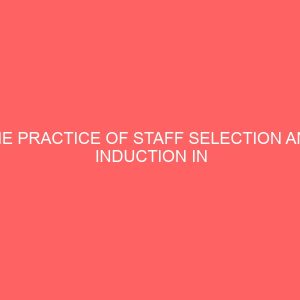Description
CHAPTER 1
1.1 BACKGROUND OF THE STUDY
Job satisfaction is the level of contentment a person feels regarding his or her job. This feeling is mainly based on an individual’s perception of satisfaction. Job satisfaction can be influenced by a person’s ability to complete required tasks, the level of communication in an organization, and the way management treats employees.Job satisfaction falls into two levels: affective job satisfaction and cognitive job satisfaction. Affective job satisfaction is a person’s emotional feeling about the job as a whole. Cognitive job satisfaction is how satisfied employees feel concerning some aspect of their job, such as pay, hours, or benefits.Many organizations face challenges in accurately measuring job satisfaction, as the definition of satisfaction can differ among various people within an organization. However, most organizations realize that workers’ level of job satisfaction can impacttheir job performance, and thus determining metrics is crucial to creating strongefficiency.
Despite widespread belief to the contrary, studies have shown that high-performing employees do not feel satisfied with their job simply as a result of to high-level titles or increased pay. This lack of correlation is an significant concern for organizations, since studies also reveal that the implementation of positive HR practices results in financial gain for the organizations. The cost of employees is quite high, and creating satisfaction relevant to the return on this investment is paramount. Simply put: positive work environments and increased shareholder value are directly related.
Some factors of job satisfaction may rank as more important than others, depending on each worker’s needs and personal and professional goals. To create a benchmark for measuring and ultimately creating job satisfaction, managers in an organization can employ proven test methods such as the Job Descriptive Index (JDI) or the Minnesota Satisfaction Questionnaire (MSQ). These assessments help management define job satisfaction objectively.
Typically, five factors can be used to measure and influence job satisfaction: Pay or total compensation The work itself (i.e., job specifics such as projects, responsibilities) Promotion opportunities (i.e., expanded responsibilities, more prestigious title)Relationship with supervisor Interaction and work relationship with coworkers.In addition to these five factors, one of the most important aspects of an individual’s work in a modern organization concerns communication demands that the employee encounters on the job. Demands can be characterized as a communication load: “the rate and complexity of communication inputs an individual must process in a particular time frame.” If an individual receives too many messages simultaneously, does not receive enough input on the job, or is unsuccessful in processing these inputs, the individual is more likely to become dissatisfied, aggravated, and unhappy with work, leading to a low level of job satisfaction.UAC PLC
Superior–subordinate communication, or the relationship between supervisors and their direct report(s), is another important influence on job satisfaction in the workplace. The way in which subordinates perceive a supervisor’s behavior can positively or negatively influence job satisfaction. Communication behavior—such as facial expression, eye contact, vocal expression, and body movement—is crucial to the superior–subordinate relationship
The research therefore seek to provide an appraisal of the concept and scope of job satisfaction with a case study of UAC PLC
1.2 STATEMENT OF THE PROBLEM
The complexity and inability of many firm to measure and determine the job satisfaction level of their employee compounds the ability of the firm to motivate their employees effectively to achieve employee job satisfaction.when employees are satisfied on their jobs they are highly motivated to perform maximally. Many organizations face challenges in accurately measuring job satisfaction, as the definition of satisfaction can differ among various people within an organization. However, most organizations realize that workers’ level of job satisfaction can impact their job performance, and thus determining metrics is crucial to creating strong efficiency.UAC PLC
Despite widespread belief to the contrary, studies have shown that high-performing employees do not feel satisfied with their job simply as a result of to high-level titles or increased pay. This lack of correlation is an significant concern for organizations, since studies also reveal that the implementation of positive HR practices results in financial gain for the organizations. The cost of employees is quite high, and creating satisfaction relevant to the return on this investment is paramount. Simply put: positive work environments and increased shareholder value are directly related.
Some factors of job satisfaction may rank as more important than others, depending on each worker’s needs and personal and professional goals. To create a benchmark for measuring and ultimately creating job satisfaction, managers in an organization can employ proven test methods such as the Job Descriptive Index (JDI) or the Minnesota Satisfaction Questionnaire (MSQ). These assessments help management define job satisfaction objectively
Therefore the problem confronting this research is to appraise the concept and scope of job satisfaction with a case study of UAC PLC.
1.3 RESEARCH QUESTION
1 What is the nature of the concept and scope of job satisfaction
2 What is the effect of job satisfaction on employee performance
3 What is the nature and effect of job satisfaction on employee performance in UAC PLC
1.4 OBJECTIVE OF THE RESEARCH
1 To determine the nature of the concept and scope of job satisfaction
2 To determine the effect of job satisfaction on employee performance
3 To determine the nature and effect of job satisfaction on employee performance in UAC PLC
1.5 SIGNIFICANCE OF THE RESEARCH
The research shall appraise the nature and impact of job satisfaction on employee performance
It shall determine measures for appraising the job satisfaction level employees and profer useful information to managers and organisations.
1.6 STATEMENT OF THE HYPOTHESIS
1 Ho Employee performance in UAC is low
Hi Employee performance in UAC is high
2 Ho Job satisfaction level in UAC is low
Hi Job satisfaction level in UAC is high
3 Ho Impact of job satisfaction on employee performance is low
Hi Impact of job satisfaction on employee performance is high
1.7 SCOPE OF THE STUDY
The study focuses on the appraisal of the concept and scope of job satisfaction and profer a case study of the impact of job satisfaction on employee performance in UAC PLC
1.8 DEFINTION OF TERMS
JOB SATISFACTION DEFINED
Job satisfaction is the level of contentment a person feels regarding his or her job. This feeling is mainly based on an individual’s perception of satisfaction. Job satisfaction can be influenced by a person’s ability to complete required tasks, the level of communication in an organization, and the way management treats employees
AFFECTIVE JOB SATISFACTION
Affective job satisfaction is a person’s emotional feeling about the job as a whole.
COGNITIVE JOB SATISFACTION
Cognitive job satisfaction is how satisfied employees feel concerning some aspect of their job, such as pay, hours, or benefits.
Genetics[edit]
It has been well documented that genetics influence a variety of individual differences. Some research suggests genetics also play a role in the intrinsic, direct experiences of job satisfaction like challenge or achievement (as opposed to extrinsic, environmental factors like working conditions). One experiment used sets of monozygotic twins, reared apart, to test for the existence of genetic influence on job satisfaction. While the results indicate the majority of the variance in job satisfaction was due to environmental factors (70%), genetic influence is still a minor factor. Genetic heritability was also suggested for several of the job characteristics measured in the experiment, such as complexity level, motor skill requirements, and physical demands.
Personality
Some research suggests an association between personality and job satisfaction. Specifically, this research describes the role of negative affectivity and positive affectivity. Negative affectivity is related strongly to the personality trait of neuroticism. Individuals high in negative affectivity are more prone to experience less job satisfaction. Positive affectivity is related strongly to the personality trait of extraversion. Those high in positive affectivity are more prone to be satisfied in most dimensions of their life, including their job. Differences in affectivity likely impact how individuals will perceive objective job circumstances like pay and working conditions, thus affecting their satisfaction in that job.[48]
There are two personality factors related to job satisfaction, alienation and locus of control. Employees who have an internal locus of control and feel less alienated are more likely to experience job satisfaction, job involvement and organizational commitment. A meta-analysis of 187 studies of job satisfaction concluded that high satisfaction was positively associated with internal locus of control. The study also showed characteristics like high machiavellianism, narcissism, trait anger, type A personality dimensions of achievement striving and impatience/irritability, are also related to job satisfaction.[
Emotion
Mood and emotions at work are related to job satisfaction. Moods tend to be longer lasting but often weaker states of uncertain origin, while emotions are often more intense, short-lived and have a clear object or cause.







